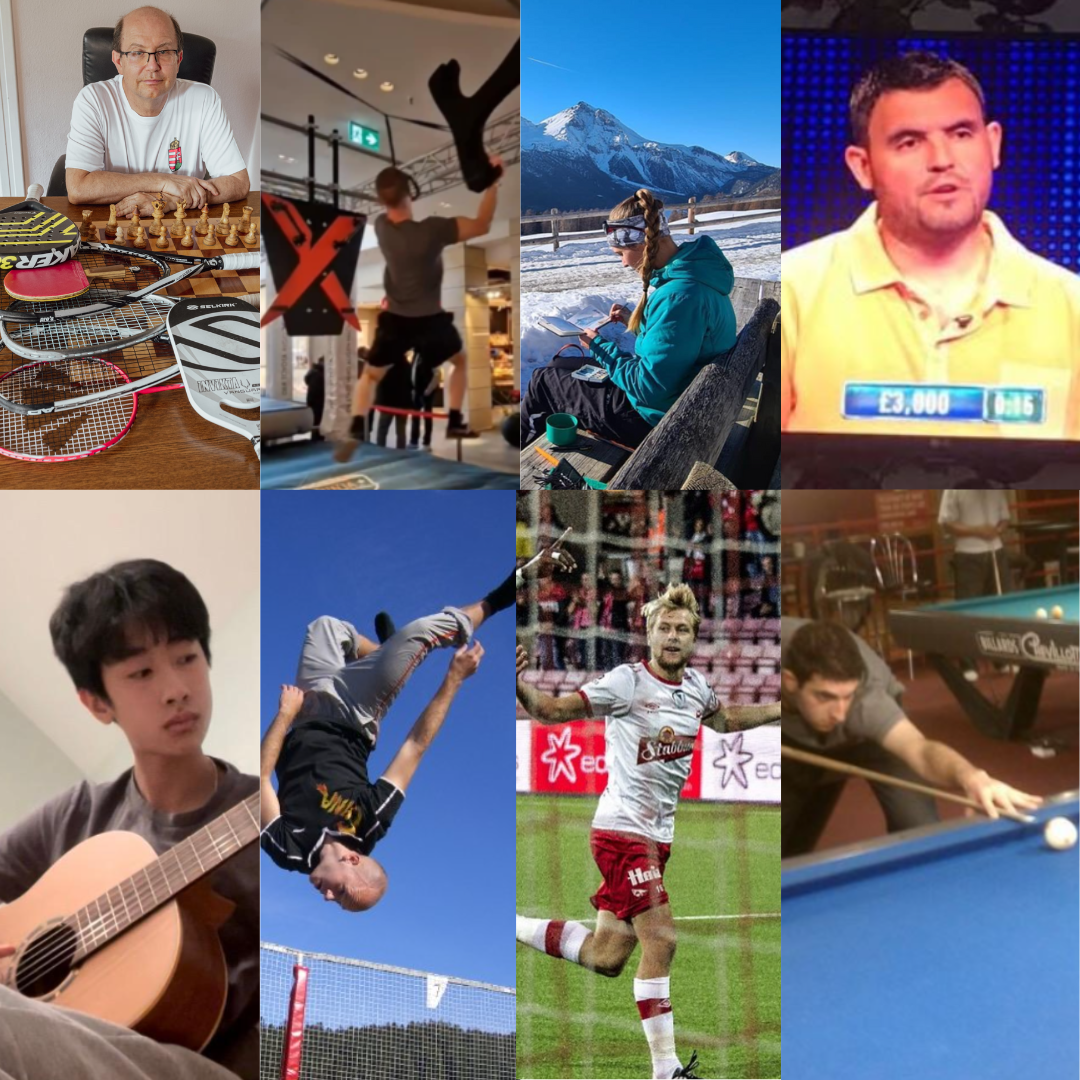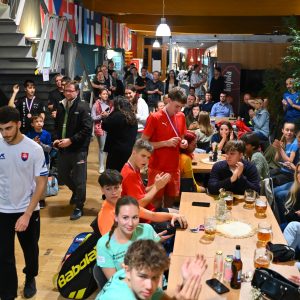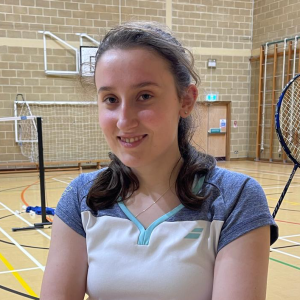We all know racketlon requires you to be skilled in table tennis, badminton, squash, and tennis, but racketlon players’ talents by no means end there. Here, in their words, are some players in our great community describing their other talents, from music, to chess, to trampolining, and much more!
Jesper Ratzer – Obstacle course running/parkour
When I stopped with racketlon actively back in 2016, I started doing obstacle training. My big inspiration was American Ninja Warrior and Japan’s Sasuke, but began doing OCR (obstacle course running) since those were the available competitions in Denmark. I also climbed a lot and built my own Ninja rig in my backyard. After completing my big running goal of doing sub 20 minutes on the 5k and getting bored of running, I changed to parkour training together with Ninja. My greatest achievements were nailing the backflip, the one arm pull up, the human flag, the free-standing handstand push up, climbing 7A, completing the course in World Ninja Open in Sweden and almost 😂 winning a Ninja tournament in Germany.

Tibor Karolyi – chess
I am a professional chess player. My best result is becoming Hungarian Champion. Hungary was very strong at chess, and is still pretty strong. Chess, like racketlon, involves fighting. There is a lot of preparation, a lot to think; what to prepare and how to prepare. Maybe the differences are great because in chess you have to start at a very early age. In racketlon you have to start early, but obviously you cannot become world class in everything. I have written roughly 40 chess books. My pupils at chess have won roughly ten medals at the World Age Group Championships and Peter Leko was my pupil for six and a half years and he was a World Championships finalist – and another player who was second at the Chess Olympics. I was five-time Hungarian champion, four times team and one individual, at chess. And I also have senior national titles at racketlon, tennis, badminton, crossminton, padel, pickleball. Four times world champion at racketlon, two doubles and two teams, and many, perhaps ten silvers. Also crossminton senior world champion at mixed doubles. And I got bronze at the World Under-26 Team Championships at chess.

Kresten Hougaard – trampolining (and other things!)
I’ve done a lot of different sports over the years. I was a talented goalkeeper, played a decent level of handball, was in the second best Danish league for volleyball as a libero (go figure why I’ve done my fair share of dives in racketlon), but my best outside of racket sports was trampoline in which I won 10 national championships through my youth and was at the national team traveling around Europe to compete. My favourite moment was winning the Danish National Championship with my little brother in the synchronized event as big underdogs. I’ve been lucky enough to win a Danish National Championship with each of my brothers. One in trampoline with my baby bro, and one in table tennis doubles with my older one. [His older brother is Jesper, who was also an elite racketlon player and now focuses more on other things including poker, at which he is a professional. We hear Kresten is good at poker too!]

Nicole Eisler – art
It is well known that sports and art complement each other well and contribute to a healthy lifestyle. Activity and calm. I decided early on that my yin would be paintbrushes and my yang would be rackets to lead a well-balanced life. I need both: the high-octane rallies on court and the meditative calm of a blank canvas. Yin, yang, and a lot of shuttlecocks. I believe the two are not only complementary but have many points of intersection. As I see it, sport is just as much a mixture of hard work and developing an intuitive game as art is a mixture of precision craftsmanship and expressive power.
In my final project for my master’s study at Zurich Art School (ZHdK), I explored the interface of sport and art, painting a film still (of my subjective camera while playing squash) on the front wall in a squash court itself. The most fun part of the work was playing squash not against the usual front wall, but directly onto the painting. The bullet holes left by the balls are part of the concept and the exploration of space and time during the game.


Back in 2008 and still an art student, when the Swiss Racketlon Federation needed a logo, I didn’t just step up to the baseline – I stepped up to the drawing board. The result: a design that players still wear on their shirts while sweating through matches, unknowingly modeling a piece of my art.
Today, for me racketlon (and other sports) still isn’t just a sport—it’s also an aesthetic and mental experience and I am still examining my experiences during sports. My artwork only began with my studies back then. However, I don’t want to present my core work online yet. Hopefully, it will find its way into galleries and exhibitions one day. But if you’re still curious about what I do besides this work and teaching art (I teach art at a school), I warmly invite you to have a look at my website.


Filip Westgaard – football
I have played football all my life. Both professionally and semi-professionally. I played for Fredrikstad football club in the OBOS Liga (the second highest division in Norway) for six years. At that time I was completely pro and didn’t work on the side. I only focused on football. It was a dream to play in front of 12,000 supporters on the football pitch. After six years at Fredrikstad football club I went down a division and played for Kvik Halden FK. Here I played semi-professionally and studied on the side. I played here for five years before I gave up football 2 years ago.
After I gave up football I needed something new to compete in. I suddenly heard about racketlon and that there was a tournament at Mysen. I had played a lot of tennis before, but was quite new to the other three sports. Then I started training with a little different racket and thought the first tournament I took part in was incredibly fun, and now I’m really hooked on racketlon and trying to play all the sports in the course of a week. Racketlon is a fantastic sport for athletes who enjoy many different things and see themselves as versatile.

Leon Griffiths – music
I got massively into music when I was like 17 or 18. I got a guitar for my 18th birthday from my uncle* and started playing all the time. I then turned up at uni and realised I was just ‘another dickhead with a guitar’, so I started playing bass because I was desperate to be in a band. I started playing in a couple of bands but found The Terms [Spotify link] who were great. In my second year at uni I lived opposite pirate studios so we used to practise all the time and it was so much fun. We won the ‘battle of bands’ at uni, had an album worth of songs and then Covid happened. Becuase of Covid I started playing bass every day for a year and got to a decent level, about grade 6, so not elite level but decent enough to play in most bands. Then after Covid we managed to play all over the Midlands, loads of gigs. They were all so much fun. We played in Nottingham loads, Yorkshire, Mansfield, we were on BBC Radio across the country; thought we were the next Arctic Monkeys… but then we left uni and went our separate ways, which was such a shame.
(*The uncle is Simon Iron, a long-time racketlon player. Leon says of him: “He was a great drummer who’s played in some fairly decent sized bands. He’s played in 5,000-plus-people venues across the country and is an excellent musician.”)

Kyler King – music
Written by his father, Leo, who introduced him to racketlon and also played on the USA 3rd team in Rotterdam this summer.
My son Kyler is a very accomplished classical guitar player studying at the world-famous music school Juilliard in Manhattan. He is a straight-A student and was also recently accepted into the prestigious Pre-College program at Juilliard School as a classical guitar major. In addition, he is fluent in Mandarin, has been studying Spanish, and is passionate about exploring different cultures. While Kyler started learning the piano at the age of 3, he really fell in love with classical guitar once he became a teenager. He’s also passionate about listening to hip-hop music.
Kyler debuted on the world stage for Team USA in Rotterdam, the only under-18 junior player, and competed in both the U14 and adult First Timer categories. Perhaps his most unforgettable moment came in the team event, when he clinched a dramatic victory for Team USA over Switzerland. With the score tied and everything riding on the gummi arm, Kyler held his nerve through a let serve and a 27-shot rally before sealing the win with a stunning stab-volley winner. It was a defining moment that his teammates – and Kyler himself – will never forget. He is excited to continue his racketlon journey and looks forward to growing the sport in the US and connecting with players and communities through this unique sport!

Ray Jordan – Quizzes
I have been doing quizzes quite a long time now, with my dad, who is quite good at quizzes. In the last few years I have been getting more into it. I was on The Chase [a popular British quiz game show on ITV] eight years ago. That didn’t go so well. I wish I sort of saved it and waited until I was a better, because you can improve and I am improving, with a lot of reading. Going to a lot of quizzes is a help in itself. Some of it is a bit of list learning. Some basic lists. A lot of these things come up more than you realise.
Once a month in the UK there’s a Grand Prix. There are six rounds. It is all written, individual. There are six rounds of questions, always the same: arts & culture, civilisation & history, entertainment, lifestyle, physical world, and sports & games. In a typical month, the people winning it will be Pat Gibson, one of the Eggheads [another popular British quiz game show], Anne Hegerty finishes quite high, some of the Chasers [the in-show team who compete against contestants in The Chase], Paul Sinha [comedian and Chaser] sometimes plays. You all do it at the same time. I have had some very good scores this year. I think in one quiz I got a higher score than Barry Simmons, one of the Eggheads.
In the World Championships I finished 936th, with 70 out of 240. It was very difficult. Just under 2,000 people took part in that. It really shines a light on the areas you are not so good at. It really makes you realise how good the good quizzers at. The UK has the biggest quiz scene, if I look at all the people who do it.
As well as that, I go to a couple of pub quizzes a week. I don’t always go, if I have table tennis or something like that. I go to that with my dad and our team. Quite a strong team when we are all together, because it is a good mixture of people. And we won last night as well. There’s a lot to be said for it. It is a nice contrast to physical sport and you are always learning. But I do become a bit of a quiz bore when someone tells me something, like ‘oh, ok that might come up in a quiz…’. Or I tell them something that came up in a quiz. So I need to watch that!


Matilda Parslow – folk music
For a number of years I played the violin in a folk band. We played at events and weddings for ceilidhs (with a ceilidh caller) and generally had a great time playing all sorts of folk music!

Alex Porush – pool
I participate in a competitive 8 ball league in NYC. In the most reason season, I finished with the highest win percentage in the league of 128 players, becoming the only player to achieve over 90% rack wins. I also led my team to clinch the championship title. There are a small handful of players in the league with higher skill ratings than me, but I use my racketlon toughness and mentality to play very strategically and execute under pressure in key moments.

James Langworthy – swimming
My grandad was a keen swimmer, he used to swim a mile or so three times a week and do star jumps and press-ups in the morning and stuff which was inspirational. He took me swimming after-school aged five to seven, twice a week, and used to gamify things like holding breath and swimming underwater the furthest, which I loved. Then I joined the local club and started training twice a week and won a fair few clean-sweep golds in the club-champs until aged 11. Until it got much harder! And even though I began training three times per week it wasn’t enough to feel the same success. I quit club aged 15, having discovered tennis at 12 and badminton at 14.
Swimming is repetitive, requires a lot of coordination and high level of fitness but it will never have the camaraderie and tactical gameplay of racketlon. I now bloody enjoy sea and open water swimming, which makes those types of holidays way more fun!
Johnny Bispham – backgammon
I was taught how to play backgammon on holiday with my parents when I was 8 or 9 and they were playing on a travel board. Really it remained something that only my dad and I would do when on holiday or I was home from uni and we didn’t want to go out. I also played a little bit on online bookies while at uni to win £20 small stake tournaments – there were a lot of bad players happy to chuck in £3 or £4 entry which would mean I could win a decent night out back then quite quickly with three tournaments an hour!
It remained that way, and I stopped the online money tournaments, until I signed up for a new tennis and squash club in 2019 and saw on their noticeboard they had a backgammon club, so I thought I’d give that a go as well to meet some new people at the club.
I started by entering their annual cup and beat the club captain, a fine player, in the 1st round (more by luck than skill, but there was by his admission some skill in there), and really then I was hooked on trying to get better and win more matches consistently. I played a few club social nights and then a global pandemic struck! During this time, because handling the same dice and checkers across a table was about the most dangerous thing you could dothen, I was introduced to playing online for fun with people I knew (rather than randomly assigned gamblers before) and a piece of software called Extreme Gammon which would tell you, similar to chess computers, when you’ve made a suboptimal move. From here, with huge amounts of spare time, I was able to refine my game learning what would be best in given game states and match states, and slowly was able to grind down my “Performance Rating” – an indicator of how well you performed vs the computer’s optimal play, with 0 being perfect.
There is really no strict ranking system is backgammon and various bodies claim they have the definitive rankings. But probably the easiest way to indicate a rough level is to look at my ELO and average PR on the most popular backgammon app. I only play speed matches on here as I hate staring at screens for ages, so this is likely a slight underestimate of my level as conventional wisdom says the longer you think about the move and calculate outcomes, the more likely you are to come up with the right play (though perhaps that’s not the case for me, who knows!). At time of writing my average PR is 5.57 which is considered an “expert level” and my ELO is 2227 (you start on 1500 on this site), which places me 708 in the world and 28 in the UK.
I’ve been fortunate enough over my time playing to play and beat a player ranked as high as UK number 1, as well as lose to him! I’ve won and lost against the man currently ranked 32 in the world on the site referred to above and just today I was randomly paired against the reigning world champion beating him 5-2 (though he did win the PR battle in that match, so luck was on my side). Last year I also won the Premier Division of a club with 24k members (though clearly a large number of those don’t play backgammon!). So overall, while it’s hard to give an exact indication of my level, it’s also (hopefully) fair to say I have a reasonable amount of skill at the game as well!
Funnily enough, I randomly got paired with Kresten online back in February and beat him. 😂

Thank you very much to everyone who contributed to this article and if you have any talents and passions, or have any friends/teammates who do, let us know. We may make a part 2!









